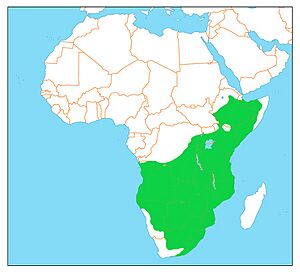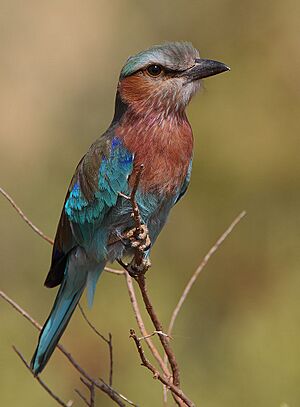Lilac-breasted roller facts for kids
Quick facts for kids Lilac-breasted roller |
|
|---|---|
 |
|
| Kruger National Park, South Africa | |
| Conservation status | |
| Scientific classification | |
| Genus: |
Coracias
|
| Species: |
caudatus
|
 |
|
| resident range | |
| Synonyms | |
|
|
The lilac-breasted roller (Coracias caudatus) is a colorful African bird. It belongs to the roller family. You can find it across southern and Eastern Africa. Sometimes, it even visits the southern Arabian Peninsula.
These birds love open woodlands and savannas. They usually avoid places without trees. Lilac-breasted rollers often sit alone or in pairs. They perch high up on trees or poles. From these spots, they can easily spot insects, small animals, and even tiny birds on the ground.
When it's time to nest, they lay 2 to 4 eggs in a natural tree hole. Both parents take turns keeping the eggs warm. They are very brave and will fiercely protect their nest. They even chase away bigger birds like raptors! During mating season, the male flies high up. He then swoops and dives, making loud, harsh calls. Young rollers don't have the long tail feathers that adult birds do. The lilac-breasted roller is thought to be the national bird of Kenya.
Contents
About the Lilac-breasted Roller
What's in a Name?
The lilac-breasted roller was first described by a Swedish scientist named Carl Linnaeus in 1766. He gave it the scientific name Coracias caudatus. The word caudatus is Latin and means "tailed." This name fits because of their long tail feathers!
The lilac-breasted roller is one of nine types of birds in the Coracias group. These birds live in the open woodlands of Europe, Asia, and Africa.
Different Kinds of Rollers
There are two main types, or subspecies, of the lilac-breasted roller:
- C. c. caudatus: This is the "lilac-breasted roller" we usually think of. It lives from central Kenya down to northern South Africa. It also goes west to the coasts of Namibia and Angola.
- C. c. lorti: This one is called the "lilac-throated roller." You can find it from Eritrea to western Somalia and northeastern Kenya.
Even though they live in different areas, these two types are very similar. Scientists don't see enough differences to call them separate species.
What Does a Lilac-breasted Roller Look Like?
These birds are easy to spot because of their bright colors! They are strong birds with large heads. You often see them sitting alone on a tree in a grassy area.
The "lilac-breasted" type has a lilac-colored throat that gets darker on its chest. Its head and back are olive green. Its cheeks are a reddish-lilac color. The "lilac-throated" type has a greenish-blue head and back. Its chest is bright blue. Both types have long, black outer tail feathers. Young birds do not have these long tail feathers.
Male and female rollers look very much alike. Males might be a bit bigger. Young birds have a reddish-brown chest with light streaks. As they grow, their colors become brighter.
An average lilac-breasted roller weighs about 104 grams. It is about 36 to 38 centimeters long. This includes its tail feathers, which are 8 to 9 centimeters long. Their wings can spread out to about 50 to 58 centimeters. Rollers have special feet where two toes are joined together. This is called syndactyl feet.
You might confuse them with other rollers. For example, the Abyssinian roller has a blue chest. The racket-tailed roller has different tail feathers.
What Do They Sound Like?
The lilac-breasted roller makes a harsh, scratchy sound. It sounds like "rak rak rak." They usually make this sound while flying. When they sing, they often sit on a branch.
Where Do Lilac-breasted Rollers Live?

Lilac-breasted rollers live all over eastern and southern Africa. You can find them from sea level up to 2,000 meters high. Their home stretches from Eritrea to South Africa. They are common in Namibia, Botswana, and Zimbabwe.
The "lilac-breasted" type usually stays in one area. But after breeding, they might move to different woodlands for a while. They return to their breeding spots when the rainy season starts. The "lilac-throated" type travels from northeast Kenya to northwest Somalia to breed. Sometimes, they even visit Oman and Yemen. Lilac-breasted rollers are most common in Kenya.
Both types of rollers live in open grassy areas with scattered trees and bushes. They need high places to sit and hunt. They also like areas near rivers and light forests. Sometimes, they go into deserts or open grasslands if there are high spots to perch.
In national parks, you might see them near roads. Especially during fires, when small animals and insects come out of hiding. They avoid cities and towns. But sometimes, farmers burn land for farming. This stirs up insects, and you can see rollers swooping down for an easy meal.
Behaviour and Life Cycle
How They Reproduce
Lilac-breasted rollers usually have one partner for life. They build their nests alone. It's hard to tell males and females apart just by looking.
Pairs protect their nest very well. One bird might fly in a rolling pattern. This warns other birds to stay away. It also helps to distract animals that might try to eat their eggs. During courtship, a male roller flies up high. Then he closes his wings and dives fast towards the ground. As he levels out, he rolls from side to side. He makes a loud, harsh "kaaa, kaarsh" sound. If another male enters their area, they might fight. They push and claw each other while flying up.
Lilac-throated rollers breed from late April to mid-September in Somalia. Lilac-breasted rollers breed at different times of the year, depending on where they live. They build simple nests of grass. They often choose a hollow in a baobab tree, a dead coconut tree, or a termite mound. Rollers don't dig these holes themselves. They use holes made by woodpeckers or kingfishers.
In Somalia, they usually lay three to four eggs. In southern Africa, they lay two to four eggs. Both parents take turns sitting on the eggs for about 22 to 24 days. When the chicks hatch, they are helpless. They grow all their feathers after about 19 days.
What Do They Eat?
Lilac-breasted rollers eat insects and small animals. This includes spiders, scorpions, and snails. They also eat small lizards, chameleons, and even small snakes. Slow-moving animals are easy for them to catch.
Because they mostly eat animals on the ground, rollers like to perch high up. They might even sit on large animals like elephants! From their high spot, they watch for prey. Then they swoop down and grab it with their beaks. If the prey is small, they swallow it right there on the ground.
Status
The International Union for Conservation of Nature (IUCN) says the lilac-breasted roller is of "least concern." This means they are not currently in danger. They have a large home range and their numbers are stable.




